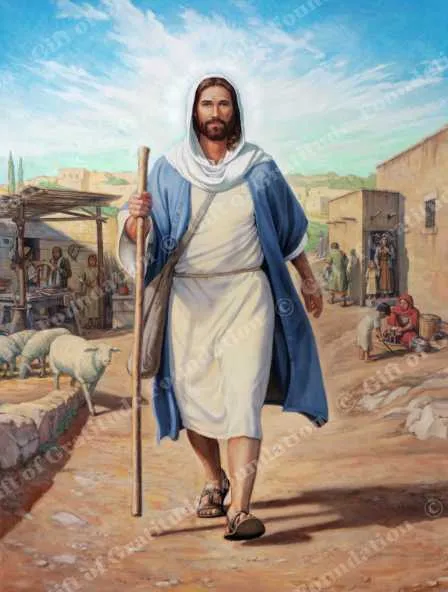Ministering
Commitment to Serve
By Scott Snow
Commitment to Serve
“Now when Jesus had heard that John was cast into prison, he departed…. And leaving Nazareth, he came and dwelt in Capernaum…that it might be fulfilled which was spoken by Esaias the prophet, saying…the people which sat in darkness saw great light; and… from that time forth Jesus began to preach, and to say, Repent: for the Kingdom of heaven is at hand” (Matthew 4:12-17).
This painting depicts the moment Jesus learns of John’s imprisonment and leaves home to start His ministry. He was committed to doing the will of the Father. His mission was to liberate all people from the bondage of sin. He healed the sick, caused the dead to rise, and taught His gospel to all people. He served His people all His life and His final and ultimate act of service was through His death.
He leaves behind His mother and His family, His life as a carpenter, and heads off as a shepherd to gather His sheep.
Christ was on a mission for His Father to teach the gospel unto men. He lived His life in service of others and with His death he liberated all men from the bondage of sin. Through the scriptures, we learn of His ministering unto the sick and afflicted, teaching obedience to God’s commandments, and performing miracles.
On Jesus’s way to Jerusalem, He stopped in a village where he found 10 lepers. Recognizing Him from a distance, they called to Him and begged for Him to heal them. Jesus told them to show themselves to the priest which was customary for lepers at that time.
Through this small act of faith, they were healed. However, only one of the lepers returned to thank Jesus for this miracle. Jesus asked where the other nine were, but they did not show.
Some may miss the significance of what Christ did for them. Leprosy would have affected every aspect of their lives. Beyond the unsightly physical disfigurement and pain, they were social pariahs as well. They were impoverished and forced to live outside the protection of the city either alone or with other lepers. After being given back their lives, returning to family, and being reintegrated into society, only one returned to express his gratitude.
This is one example of many when Jesus showed compassion and served His fellow man. During His mortal ministry, He shared the good news of the gospel and expressed His love through word and deed. Jesus continued to serve His people all His life and His final and ultimate act of service was through His death and resurrection.
John 15: 13 Greater love hath no man than this, that a man lay down his life for his friends.
Symbolism
In order to capture some of the significance of Christ’s life, extra detail was put into this painting. Jesus leaves behind His family, His carpentry shop and tools, and has only one purpose driving Him forward: to fulfill the mission His Father sent Him to perform. His mother, Mary, is in the background tearfully watching her firstborn, the Son of God, embark on his mission to minister to others and fulfill His role as Savior of the world.
This painting is filled with symbolism. These are three symbols veiled in the painting:
1. In the sky, the clouds seem to part to Him, and one can see the shape of a man facing the form of a cross.
2. The sheep graze on their straw, but one looks up and notices his shepherd walking away. Instinctively, he turns to follow His master. “My sheep hear my voice” (John 10:27).
3. Joseph is in the background holding a yoke and showing it to a new apprentice. This references that when we rely on the Lord, our burdens will be lightened. “For my yoke is easy, and my burden is light” (Matthew 11:30).

HOW TO GIVE GRATITUDE
1. Nominate an individual to whom you would like to express gratitude
2. Provide a donation to cover the artwork's production costs
3. Write out a letter of appreciation for your hero to be presented with the artwork
Nominate a Hero
Thank you for your interest in nominating someone who has served our country and defended our liberties. This includes men and women veterans, uniformed peace officers, first responders, doctors, nurses, and others who serve selflessly on behalf of their fellowmen. Please complete this form and submit it to have your nomination considered. You will be contacted if additional information or documentation is needed and you will be notified if you your nominee is chosen.
GET IN TOUCH
Ready to share your gratitude? Reach out to get started.



